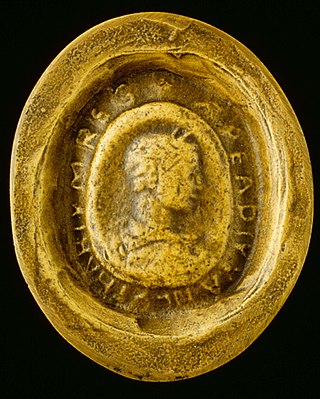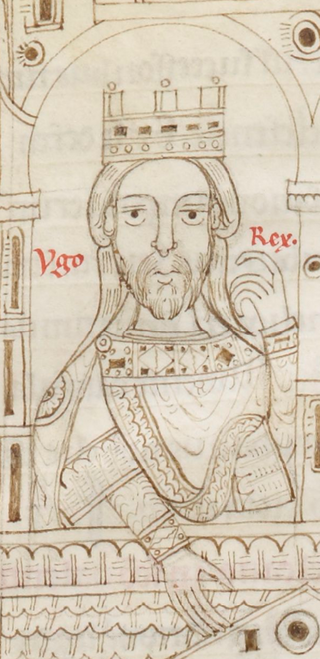Related Research Articles

Lothair II was the king of Lotharingia from 855 until his death in 869. He was the second son of Emperor Lothair I and Ermengarde of Tours. He was married to Teutberga, daughter of Boso the Elder.

Louis the Blind was the king of Provence from 11 January 887, king of Italy from 12 October 900, and briefly emperor between 901 and 905. His father was a Bosonid and his mother was a Carolingian. He was blinded after a failed invasion of Italy in 905.
Richard the Justiciar (858–921), also known as Richard of Autun, was count of Autun from 880 and the first margrave and duke of Burgundy. He attained suzerainty over all the counties of Burgundy save Mâcon and by 890 he was referred to as dux (duke) and by 900 as marchio (margrave). By 918 he was being called dux Burgundionem or dux Burgundiae, which probably signified less the existence of a unified Burgundian duchy than feudal suzerainty over a multiplicity of counties in a specific region.

Hugh, known as Hugh of Arles or Hugh of Provence, was the king of Italy from 926 until his death. He belonged to the Bosonid family. During his reign, he empowered his relatives at the expense of the aristocracy and tried to establish a relationship with the Byzantine Empire. He had success in defending the realm from external enemies, but his domestic habits and policies created many internal foes and he was removed from power before his death.

Boso was a Frankish nobleman of the Bosonid family who was related to the Carolingian dynasty and who rose to become King of Lower Burgundy and Provence.

Berengar II was the King of Italy from 950 until his deposition in 961. He was a scion of the Anscarid and Unruoching dynasties, and was named after his maternal grandfather, Berengar I. He succeeded his father as Margrave of Ivrea around 923, and after 940 led the aristocratic opposition to kings Hugh and Lothair II. In 950 he succeeded the latter and had his son, Adalbert crowned as his co-ruler. In 952 he recognised the suzerainty of Otto I of Germany, but he later joined a revolt against him. In 960 he invaded the Papal States, and the next year his kingdom was conquered by Otto. Berengar remained at large until his surrender in 964. He died imprisoned in Germany two years later.

The Kingdom of Lower Burgundy, also called Cisjurane Burgundy, was a historical kingdom in what is now southeastern France, so-called because it was lower down the Rhône Valley than Upper Burgundy.

Lothair II, often Lothair of Arles, was the King of Italy from 947 to his death. He was of the noble Frankish lineage of the Bosonids, descended from Boso the Elder. His father and predecessor was Hugh of Provence, great-grandson of Lothair II, King of Lotharingia, and his mother was a German princess named Alda.

The Kingdom of Upper Burgundy was a Frankish dominion established in 888 by the Welf king Rudolph I of Burgundy within the territory of former Middle Francia. It grew out of the Carolingian margraviate of Transjurane Burgundy southeast of the Jura Mountains together with the adjacent County of Burgundy (Franche-Comté) in the northwest. The adjective 'upper' refers to its location upstream in the Rhône river valley, as distinct from Lower Burgundy and also from the Duchy of Burgundy west of the Saône river. Upper Burgundy reunited with the Kingdom of Lower Burgundy in 933 to form the Kingdom of Burgundy, later known as Kingdom of Arles or Arelat.
Adalbert II, called the Rich, son of Adalbert I, Margrave of Tuscany and Rothild of Spoleto. He was a grandson of Boniface II, and was concerned with the troubles of Lombardy, at a time when so many princes were contending for the wreckage of the Carolingian Empire. Before his father died in 884 or 886, he is accredited the title of "count". He inherited from his father the titles of Count and Duke of Lucca and Margrave of Tuscany.
Lambert was the second son of Adalbert II of Tuscany and Bertha, daughter of Lothair II of Lotharingia. He succeeded his elder brother, Guy, as count and duke of Lucca and margrave of Tuscany on his death in 938 or 939 without heirs. In 931, before 17 October, Hugh, King of Italy, disowned and removed Lambert, giving Tuscany and the familial possession of Lucca to his brother Boso. Hugh was Guy and Lambert's half-brother, as they had the same mother. When Guy died, Hugh married Guy's widow, Marozia.
Hubert was the illegitimate son of King Hugh of Italy and his concubine Wandelmoda. He became Margrave of Tuscany in 936 and Duke of Spoleto and Margrave of Camerino in 943.
Bertha was countess of Arles by marriage to Theobald of Arles, and margravine of Tuscany by marriage to Adalbert II of Tuscany. She served as regent of Lucca and Tuscany from 915 until 916 during the minority of her son Guy of Tuscany. She was described as beautiful, spirited and courageous, while her influence over her spouse was, coupled with ambition, attributed to have involved her husbands in many wars.
Willa, known as Willa of Tuscany (911/912–970), was a medieval noblewoman. By birth, she was a member of the Bosonid noble dynasty. By marriage to Berengar II of Italy she was Countess of Ivrea from 930 to 963, and queen consort of Italy from 950 to 963.

The March of Tuscany was a march of the Kingdom of Italy and the Holy Roman Empire during the Middle Ages. Located in northwestern central Italy, it bordered the Papal States to the south, the Ligurian Sea to the west and Lombardy to the north. It comprised a collection of counties, largely in the valley of the River Arno, originally centered on Lucca.
Anscar was a magnate in the Kingdom of Italy who served as Count of Pavia, Margrave of Ivrea (929–36) and Duke of Spoleto (936–40). He is sometimes numbered "Anscar II" to distinguish him from his grandfather, Anscar I of Ivrea. Described by Liutprand of Cremona as courageous and impulsive, he died in the battle of Spoleto.
Waldrada was the mistress, and later the wife, of Lothair II of Lotharingia.
Ermengarde of Tuscany was a medieval Italian noblewoman. She was the daughter of Bertha of Lotharingia and Adalbert II, Margrave of Tuscany. She was countess of Ivrea through marriage to Adalbert I of Ivrea. Alongside her half-brother Hugh of Italy Ermengarde was an important opponent of Rudolf II of Burgundy’s rule in Italy.
Willa of Burgundy was a member of the Elder House of Welf. By birth she was a daughter of Rudolph I of Burgundy, king of Upper Burgundy. Through marriage to Boso, Margrave of Tuscany, Willa became countess of Avignon and Arles, and then margravine of Tuscany.
Willa of Spoleto was the daughter of Boniface I, duke of Spoleto. Through marriage to Hubert, Duke of Spoleto Willa became duchess of Spoleto and margravine of Tuscany.
References
- Notes
- Citations
- Sources
- Bouchard, Constance B. (1988). "The Bosonids or Rising to Power in the Late Carolingian Age". French Historical Studies. 15 (3): 407–31. doi:10.2307/286367. JSTOR 286367.
- Keller, Hagen (1971). "Bosone di Toscana". Dizionario Biografico degli Italiani. Vol. 13. Rome: Istituto dell'Enciclopedia Italiana.
- Previté-Orton, C. W. (1917). "Italy and Provence, 900–950". The English Historical Review. 32 (127): 335–47. doi:10.1093/ehr/xxxii.cxxvii.335.
- Wickham, Chris (1981). Early Medieval Italy: Central Power and Local Society, 400–1000. London: Macmillan.